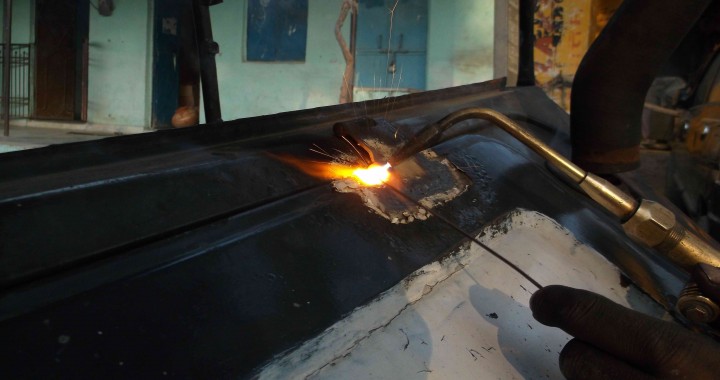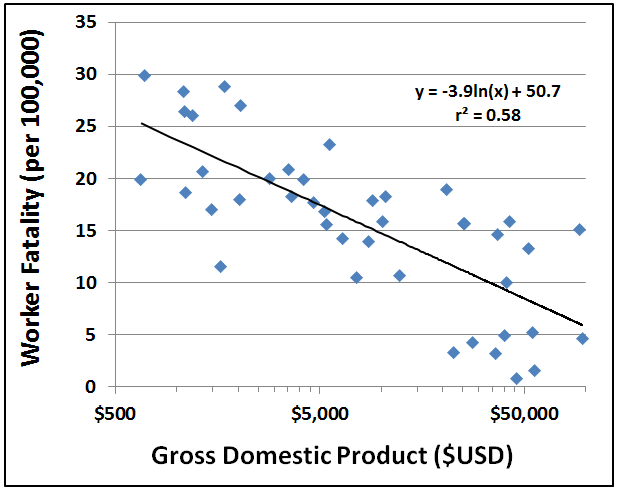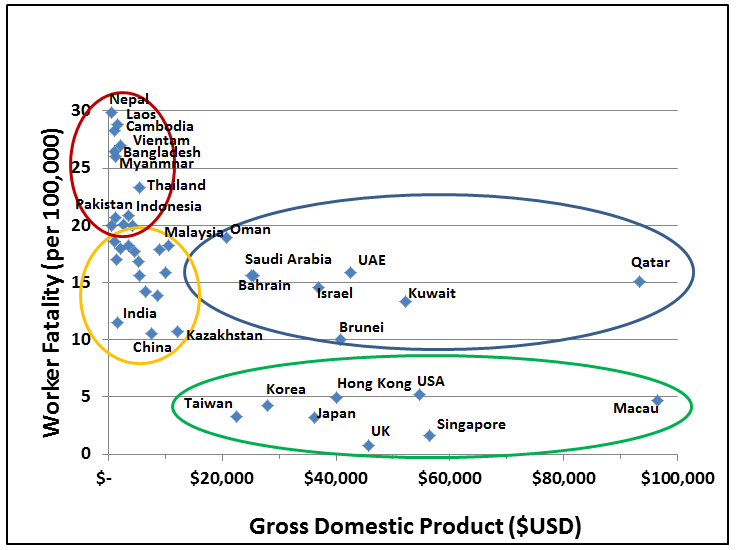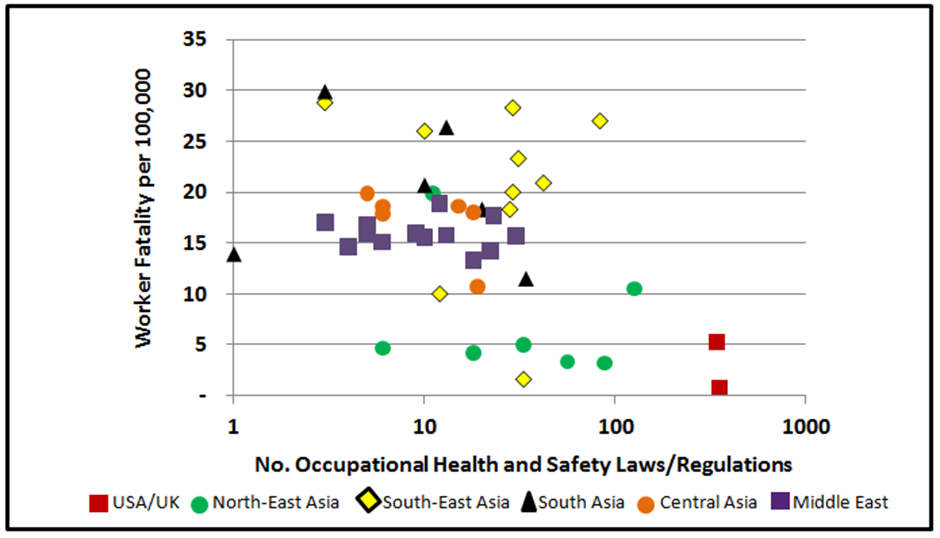Is this the OHS Wild West?
Much too frequently we read depressing news about worker health and safety in Asia:
“Deaths reported in China coal-mine explosion – Official news agency says 11 people killed in Guizhou province in nation’s second mine accident in as many days…” 7 Nov 2014 AL Jazeerah English
“Bangladesh textile workers fed up with conditions – Over 200,000 textile workers in Bangladesh have taken to the streets, some clashing with police, rioting and setting factories alight, to demand a higher minimum wage…” 25 Sept 2013 DW.com
“Death toll among Qatar’s 2022 World Cup workers revealed – Nepalese migrants have died at a rate of one every two days in 2014…” 23 Dec 2014 The Guardian
“Asbestos found in new buildings in Dubai and Abu Dhabi despite ban - Asbestos is being used in new buildings almost a decade after a nationwide ban on the dangerous construction material was imposed... in new office towers, power stations, homes and even schools.” 25 Oct 2015. The National
Every 15 seconds, a worker dies from a work-related accident or disease.
Every 15 seconds, 153 workers have a work-related accident.Every day, 6,300 people die as a result of occupational accidents or work-related diseases – more than 2.3 million deaths per year. 317 million accidents occur on the job annually; many of these resulting in extended absences from work. The human cost of this daily adversity is vast and the economic burden of poor occupational safety and health practices is estimated at 4 per cent of global Gross Domestic Product each year. Source: http://www.ilo.org/global/topics/safety-and-health-at-work/lang--en/index.htm
While there are a sobering number of news stories that one can encounter on an almost daily basis, there are in fact legal frameworks within all Asian countries for managing OHS issues.
In this blog, I will explore this topic at a 40,000 foot perspective. But, first let's define some jargon.
What are Laws, Legislation, Acts, Regulations, Standards and Guidelines?
 Terminology followed when describing health and safety laws varies among countries; below are some commonly used terms.
Terminology followed when describing health and safety laws varies among countries; below are some commonly used terms.
Legislation is a law that has been passed (or promulgated) by a governing body. For industry, occupational or worker health and safety legislation provides the legal boundaries – the laws – within which an industry or company operates. In many countries these are referred to as Acts, e.g., Factories Act or Health Act.
After legislation is passed, regulators (government bodies) will be tasked with providing the details - the regulations or standards that industry needs to follow to be compliant with the law.
Standards, as they pertain to OHS, can have different meanings depending upon the jurisdiction. For instance, US Federal OSHA Standards (29 CFR) are far encompassing and impose requirements that target industry. In other countries, e.g., Afghanistan, standards or regulations have not yet been developed.
In many jurisdictions, guidelines (or other similar documents) are issued by the responsible regulatory body to clarify and provide further details related to how to implement the laws and regulations.
For the HSE professional, it is your job to fully understand which laws, regulations, guidelines, standards and other pertinent regulatory requirements affect your business to ensure you are operating in compliance with all jurisdictional requirements.
What Is the Legal Framework for Occupational Health and Safety in Asian Countries?
The following table gives a broad summary of the state of worker health and safety (as represented by worker fatality data) and laws and regulations governing worker health and safety for each country in Asia. This is admittedly a very broad overview and in future posts I will discuss OHS laws and regulations in more detail for specific countries.
Table 1: Worker Health and Safety Laws and Regulations – Overview of Asian Countries
These data are largely from the International Labour Organization web site (http://www.ilo.com), supplemented with other sources such as country-specific government websites. In many jurisdictions there are also local regulations that add to these, e.g., in many of the GCC countries industrial cities/estates have their own requirements that are more restrictive and comprehensive than the national ones.
There is a lot of information in this table, and there are some noteworthy trends that are best viewed in figures:
Figure 1: Relationship between Worker Fatality and GDP
As we would be expected, there is a strong negative correlation between worker fatality rates and country wealth. The highest worker fatality rates (>20/100,000 workers per year) are pretty much restricted to countries with GDP less than about $5,000 per year.
There are also some patterns with respect to how Asian countries are grouped together in this figure:
Figure 2: Worker Fatality Rate vs GDP in Asian Countries
For the purpose of this discussion, four general groups are noted:
Group 1 (red): Undeveloped/developing countries with high fatality levels and with major shortcomings in laws and regulations and/or lack of enforcement and/or lack of compliance: Afghanistan, Bangladesh, Cambodia, Indonesia, Laos, Mongolia, Myanmar, Nepal, Pakistan, Philippines, Thailand, and Vietnam
Group 2 (yellow): Undeveloped/developing countries with lower fatality levels but with shortcomings in laws and regulations and/or poor/inconsistent enforcement and/or compliance: China, India, Iraq, Iran, Jordan, Kazakhstan, Kyrgyzstan, Lebanon, Malaysia, Maldives, Russia, Sri Lanka, Tajikistan, Turkmenistan, Uzbekistan, and Yemen.
Group 3 (blue): Wealthy countries with high fatality levels, generally with rapidly evolving laws and regulations but with poor/inconsistent enforcement and/or compliance: Bahrain, Brunei, Israel, Kuwait, Oman, Qatar, Saudi Arabia, and United Arab Emirates.
Group 4 (green): Wealthy countries with low fatality levels, comprehensive legal and regulatory framework, and strict enforcement and compliance: Hong Kong, Japan, Macau, Singapore, South Korea, and Taiwan.
Not surprisingly, the most highly developed countries typically have the most comprehensive legal requirements for worker health and safety, and these laws have generally been in place for more than 25 years.
At the same time however, there is no strong relationship between worker safety and the complexity and thoroughness of a county’s laws and regulations (at least as measured by the number of laws and regulations):
Figure 2: Worker Fatality Rate vs GDP in Asian Countries
As expected, USA and UK both have well developed worker health and safety regulations, which are enforced and complied with by industry – the result is low rates of worker fatalities.
The relatively wealthy countries of North-East Asia have generally less developed regulatory environments compared to US and UK but have equally low rates of worker fatalities (and this includes China – no comment here on the accuracy of these reported data!).
Across the Middle East, regardless of the vast differences in wealth among these countries and major differences in the legal and regulatory regimes, the rates of worker fatalities are high and in a tight range from 13.3 - 16.8 fatalities/100,000.
Rates on worker fatalities in SE Asian countries are very high, with the exception of the two wealthiest counties - Singapore and Malaysia.
What Does This Mean to the HSE Professional?
There are several take-home messages that can be gleaned from the above information, and in future blogs I will revisit these data to discuss other aspects. At this stage however, a few key points to consider:
Group 1 Countries
- The HSE Professional is facing a serious challenge - Good luck!
- OHS laws and regulations are generally absent, ambiguous and/or lack serious enforcement.
- There are typically limited resources to address worker health and safety issues.
- The work force that has no real understanding of health and safety issues.
- Local OHS regulator either does not exist or will provide little or no proactive help or guidance; but, expect a visit if a serious incident occurs.
- Focus on the most basic issues and training - personal PPE, sanitation, motor vehicle safety, electrical safety, etc.
Group 2 Countries
- OHS laws and regulations are often ambiguous and open to interpretation by regulators, and/or lack serious enforcement.
- It is often the case that multinationals/foreign companies will be required to operate at a higher level than local companies.
- Generally enforcement in high profile industries, such as oil and gas, is done to a higher level than other industries such as manufacturing.
- Companies may be priced out of the local and export market if they make investment for 100% compliance when their competitors are not doing so. This is hindering compliance efforts.
- Focus on the most basic issues and training - personal PPE, sanitation, motor vehicle safety, electrical safety, security, etc. and step-up training and internal processes after the basics are mastered.
Group 3 Countries
- In some ways, these are the most challenging countries to work in, because of the speed of regulatory change coupled with the general lack of experienced regulatory personnel.
- Regulatory enforcement is increasingly diligent but also sporadic.
- Workers are generally from poorer countries with a different risk tolerance and OHS background; training needs to be done at an appropriate level.
- Factory or business managers may not understand or appreciate the costs of compliance, and it can be a struggle to obtain adequate budget for implementing OHS programs.
- The HSE Manager needs to make a strong case for budget via understanding of both the requirements and the potential liability to present to senior management.
Group 4 Countries
- The large number of laws and regulations can make this challenging for the new HSE professional.
- Regulations are strictly enforced.
- The HSE Professional has many resources, e.g., national, regional and local databases, web sites, consultants and industry groups to keep informed.
- Liability protection becomes an increasingly important focus of the HSE Manager.
In future blogs I will revisit these data and also take a more detailed look at the OHS regulatory environment in specific countries.
I hope that you will bookmark the blog, share it with your colleagues and visit the blog frequently because you find it informative and helpful. I value your feedback and suggestions for future topics.
Please enter your email in the box at the top of the post and subscribe to our blog HSE Asia - our weekly blog will be emailed directly to you.
Next Week’s Blog Topic: An Overview of Environmental Laws in Asia and the Middle East
Photo Credits: Book and gavel image courtesy of and copyright Jack Moreh at freerange.com
- Is Your Business Compliant with HSE Regulations? Take Our Quiz to Find Out! - September 16, 2024
- Duty of Care: What it Is and What it Means to Companies Operating in the GCC? - January 28, 2024
- Free E-Book:Health, Safety, and Environment Regulatory Review – United Arab Emirates: An Overview of Federal Requirements - July 5, 2023




This shows real exepitrse. Thanks for the answer.
Thanks for the comment and thanks for reading the blog Kaed.
Hello Randall,
first of all I congratulate you for this article. I wanted to ask if in china there is a specific law on health and safety in the workplace or if you follow the various guidelines for the work place. thank you for what you can help me.
Donato,
Thanks for reading and I am glad you found the article useful. China has a multitude of laws and regulations pertaining to health and safety in the workplace. You need to be aware of all of them.
Download this ILO report for a good review of the situation (as on 2012) – http://www.ilo.org/wcmsp5/groups/public/@ed_protect/@protrav/@safework/documents/policy/wcms_186991.pdf
Another good one was published by NIOSH in 2015 – http://www.ncbi.nlm.nih.gov/pmc/articles/PMC4466881/
Finally, check out http://www.lexology.com/library/detail.aspx?g=77f3c523-d258-44a3-b2c1-fe80f450de9b for a discussion of the 2014 Amendment to the Workplace Safety Law.
I trust this is useful.
Regards, RDS
Very nice article
Do you have anything update from my country, Indonesia?
Thanks Transafe. For Indonesia, let us know what you are after and we may be able to help (send email to us at info@redlogenv.com). Regards
Great informative piece. I am paticularly interested in the Middle East – Group 3. Do you know specifics on tolerance levels for biocides – if there are specific regulations covering for example, ozone ( generated ozone), as well as specific hygiene norms and standards for air and water? I’m thinking from industrial use/ waste water effluent, air contaminants, etc..
Thanks for the comment and glad to hear it as informative. As for your question, yes, there are regulations in many of these countries pertaining to standards for waste water effluents, air emissions, drinking water standards, etc. We are in the process of developing a complete set of HSE legal registers and compliance auditing tools for the GCC countries; these will have the information you desire and and will be available for download via our web site at a nominal cost. For most countries, this information is publicly available but not always easy to locate. Good luck and check back in a few months if you are interested in the legal registers.
Great information I am searching for. Thank you so much for your effort. BTW, I found a typo error in the year of legislation of Korea ISHAct. It was 1981.
Glad to know this was useful for you and thanks for catching the typo.
Dear Randall,
Lovely article. There some very good stats that are presented. Being from India, what u said is exactly true. I’d love to hear more on “Culture change” rather than how bad the situation is……..
Naveen – thanks for reading and for taking the time to comment. Yes, would be nice to be able to report on positive steps being made, and there are some I am sure. But, still most countries (and by this I mean regulators, businesses and workers) are a long way from taking worker safety issues seriously. The underlying cultural issues affecting worker safety include a myriad of socio-economic factors that are by no means consistent among countries or even within countries. An interesting and challenging topic to consider for the future, thanks for the idea.
Dear Mr Randall,
First of all, I would like to thank you for sharing this useful and interesting article. I am from Indonesia and have interest and curiosity about in HSE laws and regulation in middle east and Asia but facing difficulities to verify validity of laws and regulations that I’ve found in internet. It must be nice to read your further explanation about comparation between law and regulation in those countries.
Muthia, Thanks for reading and I am pleased that you find this useful. You are definitely highlighting an important issue in that it is almost impossible to find a complete set of HSE laws and regulations for many jurisdictions. The task to build a complete HSE register for a particular country is not at all simple. This typically requires review of various websites and even the national legal gazettes for the legislation, and then searching for implementing regulation (which may or may not be available online). Indeed, on the our main consulting services is providing legal registers and compliance audits for our clients that are facing these issues. I do intend to start writing articles on recent HSE legislation in various countries, and hopefully you will find these of interest. Regards.